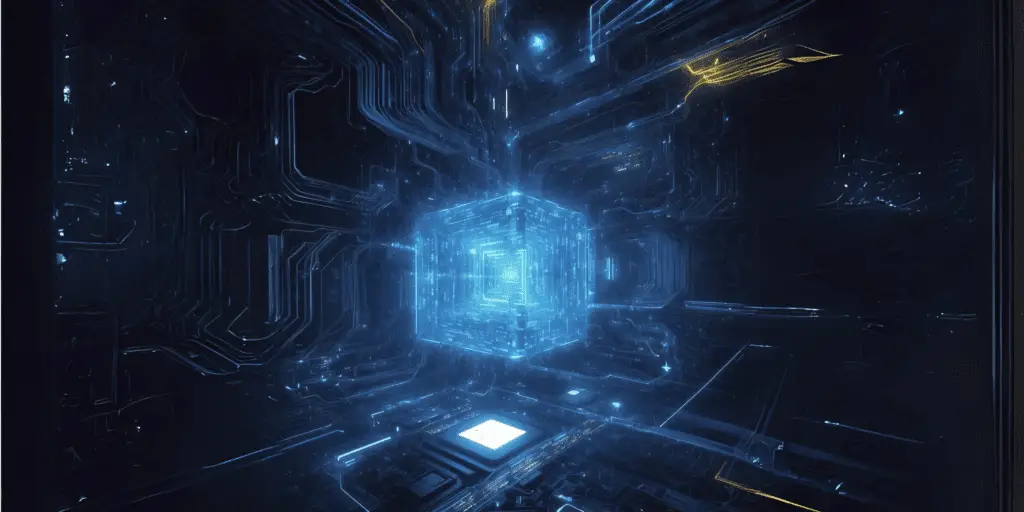In an era where technological innovations continue to blur the lines between the physical and the digital, spatial computing emerges as a transformative force, poised to redefine our interaction with the digital world.
This cutting-edge technology, which integrates the physical environment with digital data in a three-dimensional context, is rapidly becoming the next frontier in tech. Leading this charge into the future is Apple, a company that has consistently been at the forefront of technological innovation.
With the introduction of the Vision Pro headset, Apple is not merely participating in the spatial computing revolution but is setting new standards and expectations for what this technology can achieve.
Although it may sound futuristic, the concept of spatial computing is not entirely new. It has been evolving quietly in the background for years, gaining momentum as advancements in hardware and software have caught up with the visionary ideas behind it.
Spatial computing promises a more natural and intuitive way of interacting with digital information, where physical movements in the real world translate into actions in the digital space. It’s a leap towards making digital interaction second nature, akin to how we navigate our physical surroundings.
Apple’s Vision Pro represents a significant milestone in the journey of spatial computing from niche applications to mainstream acceptance. It embodies the potential of this technology to enhance various aspects of daily life, from professional work environments to personal entertainment and beyond.
The Vision Pro headset, coupled with Apple’s proprietary visions, offers a glimpse into a future where technology seamlessly integrates into our physical world, offering immersive experiences that were once the domain of science fiction.
Understanding Spatial Computing
Spatial computing represents a significant leap forward in how we interact with technology, marking a departure from traditional screen-based interfaces to a world where digital and physical realities converge. This revolutionary approach to computing is not just about enhancing our digital experiences but fundamentally redefining them.
At its core, spatial computing integrates the digital and the physical in a seamless, interactive 3D space. It enables users to manipulate digital objects as if they were physical ones, using natural movements and gestures.
This technology relies on various sensors, advanced algorithms, and display technologies to create a digital overlay on the physical world, allowing for a more intuitive and immersive interaction with digital content.
The concept of spatial computing has been around for several decades. Still, it gained significant traction in the early 2000s with the advent of more sophisticated sensing and display technologies.
The term itself was coined by Simon Greenwold in 2003, who envisioned a form of computing where interactions with digital content are grounded in our physical environment.
Spatial computing has evolved from a theoretical concept into a practical technology with applications in gaming, education, healthcare, and more.
Spatial computing creates a digital representation of the physical environment, known as spatial mapping. This process involves capturing detailed information about the surroundings using cameras, sensors, and, sometimes, LiDAR technology.
The system then processes this data to understand the layout and dimensions of the space, allowing digital objects to be placed within it in a way that appears to coexist with physical objects.
Interaction in spatial computing environments can be facilitated through various means, including touch, voice commands, eye tracking, and gesture recognition. This multimodal approach ensures that users can interact with the digital elements as naturally and intuitively as possible.
The applications of spatial computing are vast and varied, ranging from augmented reality games that overlay digital content in the real world to virtual reality environments for training and simulation.
In the professional realm, spatial computing can transform how designers and architects visualize their work, allowing them to explore and manipulate 3D models as if they were tangible objects. In education, it opens up new avenues for interactive learning, allowing students to explore complex concepts in a more

How Spatial Computing Works
Spatial computing represents a paradigm shift in how we interact with digital information, transforming our physical environment into an interactive digital canvas. This technology is not confined to the screens of our devices; instead, it extends computing into the three-dimensional space around us.
Understanding how spatial computing works involves exploring the technologies and processes enabling this seamless digital and physical integration.
The first step in spatial computing is capturing detailed information about the user’s physical environment. This is achieved through various sensors, including cameras, infrared sensors, depth sensors, and sometimes LiDAR technology.
These sensors collect data on the surroundings, such as shapes, distances, and the relative position of objects. Advanced devices, like Apple’s Vision Pro headset, are equipped with multiple sensors to create a comprehensive 3D map of the environment.
Once the environment is sensed, the next step is spatial mapping. This involves processing the collected data to construct a digital representation of the physical world.
Advanced algorithms analyze the sensor data to identify surfaces, objects, and the geometry of the space. This 3D spatial map is crucial for accurately placing digital content in the physical world, ensuring that virtual objects interact realistically with the user’s environment.
The system can overlay digital content onto the real world with a detailed spatial map. This content is rendered in real-time, allowing it to appear as if it exists within the physical space.
Rendering engines play a crucial role here, calculating the perspective, lighting, and shadows to ensure that virtual objects are displayed in a way that is consistent with the user’s viewpoint and the environmental conditions.
Spatial computing environments are designed to be interactive. Users can manipulate virtual objects using natural gestures, gaze, voice commands, or handheld controllers.
Eye-tracking technology, for example, allows the system to determine what the user is looking at, enabling interaction through simply looking at objects. Gesture recognition and haptic feedback devices can provide tactile sensations, making the digital content feel more tangible.
Combining these technologies results in immersive experiences that blur the line between the digital and physical worlds. In spatial computing, digital information is not just displayed; it is woven into the fabric of our physical surroundings.
This allows for applications that range from augmented reality games and virtual reality simulations to practical tools for education, design, and remote collaboration.
Software platforms, like Apple’s vision, are critical in spatial computing. They provide the framework for developing and running applications that can leverage the capabilities of spatial computing hardware.
These platforms manage the complex tasks of sensing, mapping, rendering, and interaction, simplifying the development of spatial computing applications and ensuring a consistent user experience.
While spatial computing offers exciting possibilities, it also presents challenges. These include ensuring user privacy, minimizing hardware intrusiveness, and overcoming technical limitations such as battery life and processing power.
With ongoing advancements in technology and the entry of major players like Apple into the spatial computing market, the future of spatial computing looks promising. It has the potential to revolutionize how we interact with digital content and how we perceive and navigate the world around us.
Apple’s Foray into Spatial Computing
Apple’s entry into the spatial computing arena marks a significant milestone in the evolution of interactive technology, signaling an expansion of its product lineup and a strategic move to redefine user experiences.
By unveiling the Vision Pro headset, Apple brings its hallmark of innovation, design excellence, and ecosystem integration to the spatial computing field.
This move is a bold step towards popularizing spatial computing among mainstream users, drawing on Apple’s history of transforming niche technologies into household essentials.
The Vision Pro and Apple’s proprietary visions offer a glimpse into a future where digital and physical realms merge seamlessly, enabling users to navigate apps and media through intuitive gestures, eye movements, and voice commands.
This foray is particularly significant given Apple’s track record of setting industry standards and driving consumer adoption. By leveraging its robust platform and focusing on user-friendly design, Apple aims to address some critical challenges in spatial computing, such as device accessibility and user interface complexity.
As Apple continues to innovate in this space, its Vision Pro headset is poised to enhance personal entertainment and productivity and catalyze new applications in education, design, healthcare, and more.
Apple’s venture into spatial computing is thus not just an addition to its product ecosystem but a strategic move that could shape the future of how we interact with technology, making spatial computing an integral part of daily life.
Applications and Impact of Spatial Computing
With its ability to merge the digital and physical realms, spatial computing is poised to bring about transformative changes across a broad spectrum of industries, offering a new paradigm for interaction and immersion.
Gaming and entertainment introduce a level of engagement where digital elements are integrated into our physical environment, as seen in augmented reality games like Pokémon Go, which turn the world around us into an interactive playground.
This technology extends its influence to education and training, where it can visualize complex concepts in three dimensions and create realistic simulations for hands-on learning, significantly enhancing the educational process and offering a more intuitive understanding of intricate subjects.
Designers and architects benefit from spatial computing by being able to prototype and visualize their work in real-time within the intended space, streamlining the design process and enabling more efficient decision-making.
In healthcare, spatial computing offers groundbreaking applications, from augmenting surgical precision with real-time data overlays to designing engaging rehabilitation exercises, improving patient care and treatment outcomes.
The technology also redefines remote work and collaboration by creating virtual workspaces that support real-time interaction with digital content in a shared 3D space, overcoming the limitations of traditional video conferencing and fostering a sense of presence among team members.
In the retail sector, spatial computing enhances customer experiences by allowing them to preview products in their own space before purchase, and in marketing, it introduces innovative engagement strategies through interactive advertisements and virtual showrooms.
It aids urban planners and environmental designers in simulating and assessing the impact of their projects, contributing to more sustainable and efficient urban development.
Despite facing challenges such as hardware limitations and privacy concerns, the ongoing advancement and increasing accessibility of spatial computing technology are expected to drive its integration into more areas of our lives.
Heralding a future where digital and physical worlds are indistinguishably intertwined, catalyzing innovation and expanding the horizons of what is possible in an increasingly digital society.

Challenges and Future Prospects
While promising, the journey of spatial computing navigates through a landscape of challenges that must be addressed to unlock its full potential. One of the primary hurdles is the hardware limitation, which encompasses the bulkiness of devices, limited battery life, and the need for more sophisticated sensors to accurately map and interact with the physical world.
These technological constraints currently hinder the widespread adoption of spatial computing, making it less accessible to the average consumer.
There are significant privacy and security concerns related to the collection and processing of data in real-world environments, raising questions about how to safeguard personal information in a world where digital and physical spaces merge.
User experience also presents a challenge, as creating intuitive interfaces that seamlessly blend with users’ natural interactions in three-dimensional space requires further innovation and refinement.
Despite these obstacles, the future prospects of spatial computing are bright, driven by rapid advancements in technology and a growing ecosystem of developers and companies investing in this space.
As hardware becomes more sophisticated and compact, we can anticipate a new generation of more comfortable devices with longer battery life and enhanced capabilities, making spatial computing more accessible and appealing to a broader audience.
As concerns regarding privacy and security are addressed through robust frameworks and regulations, users’ trust in spatial computing technologies is likely to increase.
The evolution of user interfaces, fueled by artificial intelligence and machine learning, promises to make interactions more natural and immersive, further expanding spatial computing applications across various sectors.
From revolutionizing how we work and learning to transform entertainment and social interactions, spatial computing can redefine our relationship with digital technology.
As we progress, the convergence of these advancements will pave the way for a future where spatial computing becomes an integral part of everyday life, offering endless possibilities for innovation and new forms of interaction.
Final Thoughts
Spatial computing stands on the brink of transforming our interaction with technology, promising to weave digital experiences seamlessly into the fabric of our physical world. As it evolves, this technology challenges our traditional notions of computing, pushing the boundaries of what is possible within virtual and augmented realities.
Despite facing significant challenges related to hardware limitations, privacy concerns, and user experience, the prospects of spatial computing are undeniably promising. With technological advancements and a concerted effort to address these challenges, spatial computing is poised to become more accessible, immersive, and intuitive.
Apple’s foray into this domain with the Vision Pro headset exemplifies the potential for spatial computing to become mainstream, signaling a future where digital and physical realms are indistinguishably intertwined.
As we look ahead, the continued development and adoption of spatial computing will unlock new opportunities for innovation, redefine industries, and enhance our daily lives in ways we are just beginning to imagine.
The journey of spatial computing is just getting started. Its full impact remains to be seen, but what is clear is its capacity to revolutionize our digital experiences, making them more integrated, interactive, and immersive than ever before.


